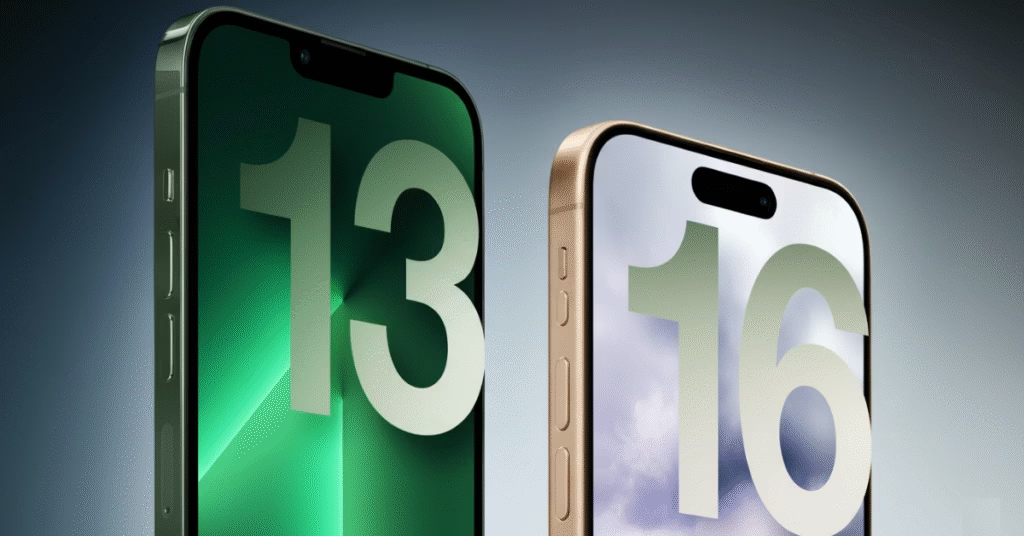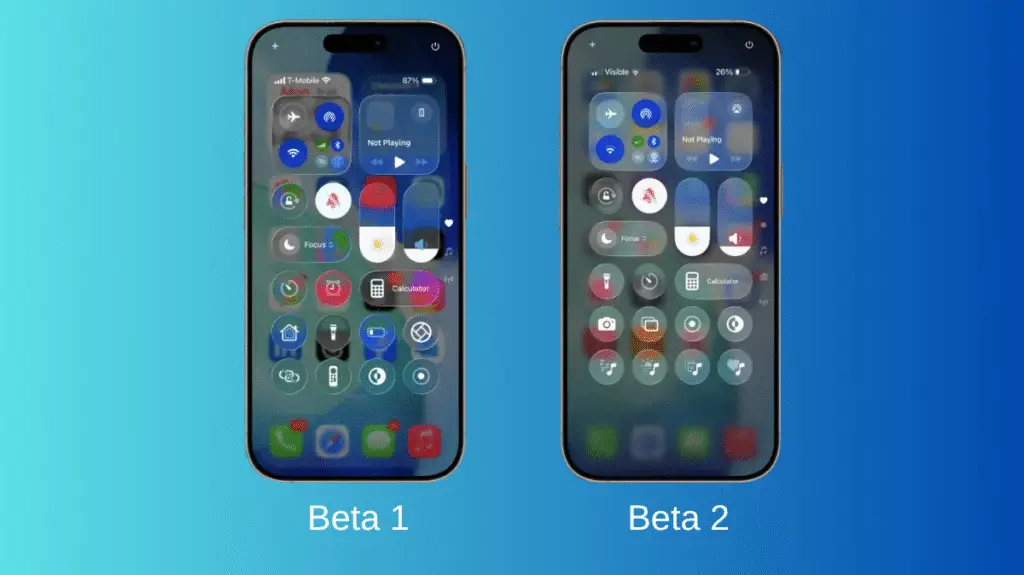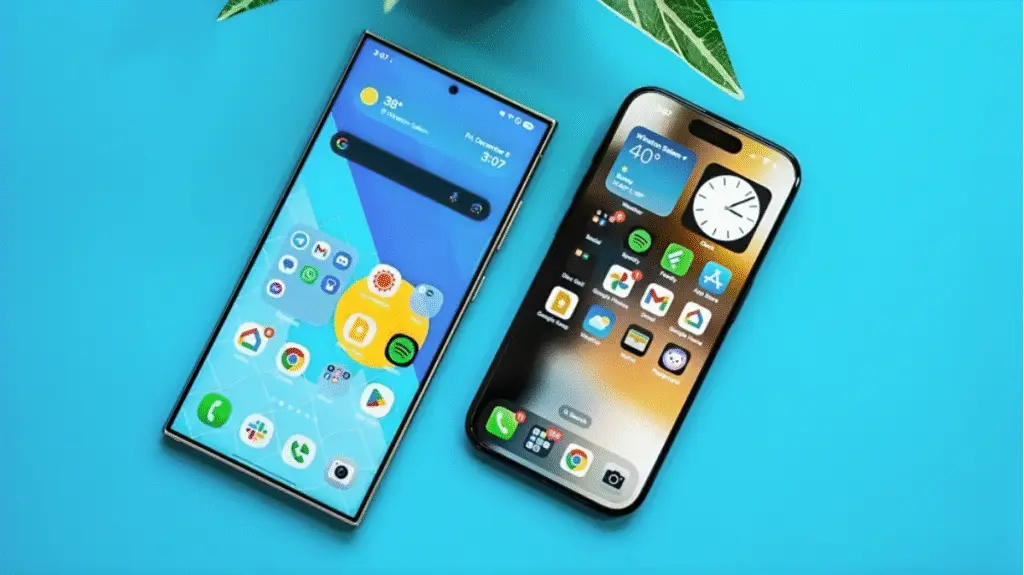
Apple has always been known for making some of the most refined smartphones in the industry, and two of its most talked-about flagships are the iPhone 13 Pro Max and the iPhone 16 Pro Max. While both are excellent in their own right, the question for many users is simple: is the jump from the 13 Pro Max to the 16 Pro Max worth it, or does the older device still hold its ground? Let’s dive into the details and see how these two stack up across design, performance, battery, cameras, and overall value.
Design and Build
The iPhone 13 Pro Max introduced a bold stainless steel frame with squared edges, giving it a shiny and solid look. However, that glossy finish also meant it picked up scratches and fingerprints fairly easily. Fast forward a few years, and the iPhone 16 Pro Max refines the formula with a titanium frame. The titanium build not only feels more premium but also makes the phone noticeably lighter. At 227 grams, the 16 Pro Max is slimmer in hand compared to the 240-gram 13 Pro Max, even with its larger screen.
Apple also redesigned the ergonomics. The newer model features slightly curved edges, which makes it more comfortable to hold for long periods. Another small but important update is the new Camera Control button on the side of the 16 Pro Max, giving quick access to photography and video shortcuts. The older 13 Pro Max, on the other hand, sticks with the familiar button layout and Lightning port, whereas the latest Pro Max finally adopts USB-C.
Quick Comparison
| Specification | iPhone 13 Pro Max | iPhone 16 Pro Max |
|---|---|---|
| Build | Stainless steel frame, flat edges | Titanium frame, curved edges, lighter |
| Weight | 240g | 227g |
| Display | 6.7″ OLED, 120Hz, 1200 nits HDR | 6.9″ OLED, 120Hz, 1600 nits HDR, 2000 nits peak |
| Always-On Display | No | Yes |
| Main Cameras | 12MP wide + 12MP ultra-wide + 12MP telephoto | 48MP wide + 48MP ultra-wide AF + 12MP telephoto (5x zoom) |
| Front Camera | 12MP | 12MP with advanced neural engine |
| Chipset | A15 Bionic + 6GB RAM | A18 Pro + 8GB RAM |
| Battery | 4422 mAh, 29 hrs video playback | 4685 mAh, 33 hrs video playback |
| Charging | Lightning, 15W MagSafe | USB-C, 25W MagSafe |
| Software | iOS 15 (upgradable) | iOS 18 with Apple Intelligence |
| Connectivity | 5G, Wi-Fi 6, SIM tray | 5G, Wi-Fi 7, eSIM (US) |
| Launch Price | $1,099 / €1,249 / £1,049 | $1,199 / €1,399 / £1,199 |
| Current Price | $428 / €478.88 / £390 | $949.97 / €1,099 / £975.99 |
Disclaimer: Specs and prices may vary by region. Check Apple’s official site for confirmation.
Display Experience
Apple’s display technology has always been a standout, and here’s where the differences become even more noticeable. The iPhone 13 Pro Max comes with a 6.7-inch Super Retina XDR OLED panel, offering up to 1,200 nits peak brightness for HDR content and 120 Hz ProMotion. It’s sharp, colorful, and fluid even by today’s standards.
The iPhone 16 Pro Max raises the bar with a slightly larger 6.9-inch screen. What’s more impressive is the boost in brightness: 1,600 nits for HDR and up to 2,000 nits outdoors. That makes a huge difference if you’re often using your phone under direct sunlight. It also introduces Always-On Display, something missing from the 13 Pro Max.
Both models use PWM (pulse-width modulation) for brightness control, which may cause eye strain in a small percentage of users, but for most people, the higher flicker rate on the newer model means it won’t be noticeable.
Camera Systems
This is perhaps the biggest leap between the two generations. The iPhone 13 Pro Max features a triple-lens system with 12-megapixel wide, ultra-wide, and telephoto cameras. At the time, it was a powerhouse, offering great photos in all conditions and support for ProRAW and ProRes video.
The iPhone 16 Pro Max, however, is a different beast. It comes with a 48-megapixel main sensor, a 48-megapixel ultra-wide with autofocus, and a 12-megapixel telephoto offering up to 5x optical zoom. It also supports 4K video at 120fps, an upgrade over the 13 Pro Max’s 60fps limit. Another new feature is spatial video capture, preparing for Apple’s push into immersive content with devices like the Vision Pro headset.
On the front, both devices have a 12-megapixel selfie camera, but the 16 Pro Max benefits from a more advanced neural engine, improved microphone system, and software-driven tools that enhance video calls and recordings.
Performance and Speed
Under the hood, the iPhone 13 Pro Max is powered by Apple’s A15 Bionic chip with 6 GB of RAM. Back in 2021, it was one of the fastest processors in any phone, and even today it still performs very well for everyday apps, gaming, and multitasking.
The iPhone 16 Pro Max, however, uses the brand-new A18 Pro chip paired with 8 GB of RAM. Benchmarks aside, real-world use shows the newer phone can handle heavier tasks like exporting 4K video in nearly half the time compared to the older device. That’s a big deal for content creators or anyone who relies on their phone for video editing and demanding apps.
For gaming, both are smooth, but the 16 Pro Max feels snappier and maintains performance longer thanks to a new thermal system that keeps heat under control. It’s also better positioned to handle Apple Intelligence features, which require the extra memory and neural processing power.
Battery Life and Charging
One of the reasons the iPhone 13 Pro Max became so popular was its outstanding battery life. With a 4,422 mAh battery, it could easily last two days for moderate users. The iPhone 16 Pro Max packs a slightly larger 4,685 mAh unit, giving it around 33 hours of video playback compared to 29 hours on the 13 Pro Max.
While both support MagSafe wireless charging, the newer model has faster speeds, supporting up to 25W with Apple’s latest adapter, compared to 15W on the older model. On wired charging, the difference isn’t as dramatic, but the move to USB-C makes the 16 Pro Max more future-proof and versatile.
Software and Longevity
When it comes to software, both phones run iOS, but the 16 Pro Max enjoys the latest iOS 18 with Apple Intelligence. That means features like advanced Siri, AI-powered writing tools, image creation with Genmoji, and improved photo editing are exclusive to newer models with enough RAM to support them.
The 13 Pro Max still delivers a solid iOS experience, but its updates will eventually end sooner. Based on Apple’s track record, the 16 Pro Max will likely receive two to three years of additional updates beyond the older device. If you care about long-term support, the newer model is the safer bet.
Connectivity
The iPhone 13 Pro Max supports 5G, Wi-Fi 6, and millimeter wave in certain regions. It also retains the physical SIM tray, which some users prefer. On the other hand, the iPhone 16 Pro Max has upgraded to Wi-Fi 7 and eSIM only in the United States, while still supporting 5G worldwide. Faster wireless performance makes it more future-ready, though some may miss the convenience of swapping SIM cards.
Value for Money
Pricing has always been a key factor when comparing iPhones across generations. The iPhone 13 Pro Max originally launched at $1,099 / €1,249 / £1,049, while today it can be found for around $428 / €478.88 / £390 if you buy it used or refurbished. On the other hand, the iPhone 16 Pro Max launched at $1,199 / €1,399 / £1,199 and is currently selling for about $949.97 / €1,099.00 / £975.99.
That price gap highlights two very different value propositions. The older 13 Pro Max still offers a flagship-level experience at nearly half the cost of today’s new model, making it a strong choice for budget-conscious buyers. Meanwhile, the 16 Pro Max justifies its higher price with upgrades like titanium design, the new camera control button, a larger and brighter 6.9-inch display, Apple Intelligence features, and faster USB-C charging. For those who want the latest innovations, the premium feels reasonable, but for many users, the 13 Pro Max remains an excellent deal.
Final Thoughts
So, is it worth upgrading? If you already own the iPhone 13 Pro Max and you’re happy with its performance and camera quality, there’s no urgent need to switch. It’s still a reliable phone with strong battery life and plenty of power for daily use.
However, if you’re after the latest design, higher-end video features, improved durability, and want access to Apple’s new intelligence tools, the iPhone 16 Pro Max makes a compelling case. For those coming from older models, skipping straight to the 16 Pro Max is the smarter choice.
In short, the 13 Pro Max remains a fantastic option for budget-conscious buyers, while the 16 Pro Max is the ultimate iPhone for those who want the very best Apple has to offer today.
See Also iPhone 17 vs Samsung s25: Which Flagship Offers Better Value in 2025?
FAQs
What is the current price of the iPhone 13 Pro Max?
The iPhone 13 Pro Max is no longer sold directly by Apple, but it’s widely available refurbished or used. Current prices hover around $428 / €478.88 / £390, which is less than half its original launch price of $1,099 / €1,249 / £1,049.
How much does the iPhone 16 Pro Max cost?
The iPhone 16 Pro Max launched at $1,199 / €1,399 / £1,199, and it currently sells for about $949.97 / €1,099.00 / £975.99, depending on region and storage choice.
Is it worth upgrading from iPhone 13 Pro Max to iPhone 16 Pro Max?
If you care about brighter displays, titanium build, Apple Intelligence features, faster USB-C charging, and a major camera upgrade, the iPhone 16 Pro Max is worth it. But if you want great performance and battery life at a much lower cost, the 13 Pro Max is still an excellent choice.
What are the main design differences between the two models?
The 13 Pro Max uses stainless steel with squared edges, while the 16 Pro Max has a lighter titanium frame with curved edges, making it more comfortable to hold.
Do both models support iOS updates?
Yes. The iPhone 13 Pro Max should receive updates for at least a couple more years, while the iPhone 16 Pro Max, being newer, will likely receive iOS support until the early 2030s.



